The music of spectacular fountains, two small twin buildings with exquisite frescoes, a peperino rock table for outdoor dining, flowers, and lemon trees, contribute to a unique display of power and splendour of a sophisticated cardinal who aspired to become Pope.
At the end of the 15th century Cardinal Raffaele Riario turned this area into his hunting ground. About one century later, in 1573, the recently-appointed Bishop of Viterbo Cardinal Francesco Gambara decided to convert the land into a spectacular garden with water features. Traditionally attributed to hydraulics-expert Tommaso Ghinucci from Siena, the water features are structured in a sequence of terraces going down from the top of the hill in a dynamic pattern of sprays and small cascades, leading the water to a calmer parterre d’eau below: along the main axis there is a series of fountains named Fontana del Diluvio, Fontana dei Delfini, Fontana dei Fiumi, Fontana della Cavea, plus the sculpted stairway cascade, the Cardinal’s dining area and four fishponds. Here, among the skilfully designed boxwood flowerbeds, at the centre of an island bordered with balustrades we find the elegant “Quattro Mori” (four moors) a sculptural group in local peperino rock, that when wet glistens as if it were bronze. On top of the sculpture is the Montalto crest, belonging to Cardinal Alessandro who in 1590 had taken possession of the villa and had commissioned this work, together with a second pavilion matching the pre-existing one built by order of Gambara. The formal garden with boxwood and yew hedges, flowering rhododendrons, hydrangeas and camelias, examples of ancient Platanus orientalis, is surrounded by an oak, maple, hornbeam, bay and holm oak tree wood. Granted by Pope Alexander VII to Duke Ippolito Lante della Rovere in 1656, Villa Lante remained in the family’s possession until 1953 and in 1970 it was bought by the Italian State.
Highlights
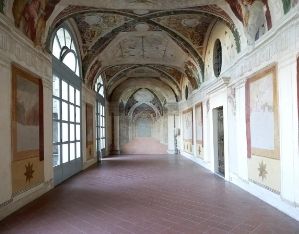
The twin pavillions
The first palazzina commissioned by Cardinal Gambara has a loggia decorated with grotesques and views of his friends’ villas and of Villa Lante itself, while the hunting and fishing rooms have landscapes by Antonio Tempesta; the second palazzina, similar and symmetric to the first, has marine views by Agostino Tassi.
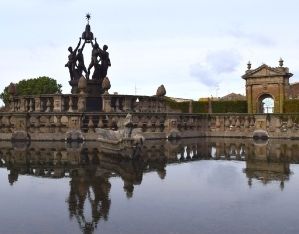
Fontana dei Mori
Attributed to Giovanni Guerra or Taddeo Landini, this fountain was created for Cardinal Alessandro Montalto, nephew of Sixtus V. Four moors, placed on a small island bordered with balustrades at the centre of four fishponds, elegantly hold the Cardinal’s crest.
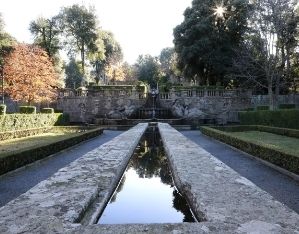
The Cardinal’s Table
On a terrace at the centre of the central itinerary there is a large table in peperino rock the Cardinal used for outdoor dining. Along the central axis there is a deep groove for water to flow and where drinks were placed too cool.
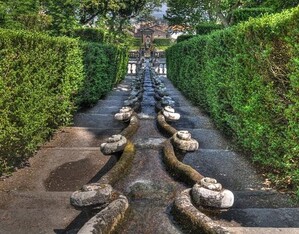
The sculpted stairway cascade
With its powerful organic-like volute structure, this sculpted stairway cascade can be read an allusion to the shrimp, the family emblem of the first owner of the villa, Cardinal Gambara. At the end of the cascades, we find another shrimp ridden by a mermaid blowing into a shell.
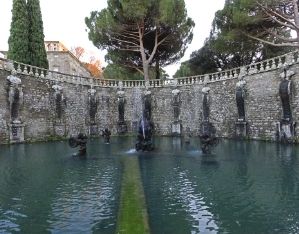
Fontana del Pegaso
The itinerary in the wood area starts at this fountain, a large oval basin bordered by a balustrade with at the centre the winged horse Pegasus that by stomping its hoof makes the water flow from Mount Parnassus, home of the Muses, an allusion to the kingdom of Nature from which Art flows.
 Villa Lante
Contacts
Villa Lante
Contacts
Contacts
Telephone:+39 0761 288008
Address
Via Jacopo Barozzi, 71
01100, Bagnaia (VT)

Ministero per i beni e le attività culturali e per il turismo
 Villa Lante
Opening times and prices
Villa Lante
Opening times and prices
Opening hours
Pricing
- Full price: € 5,00
- Reduced price: € 2,00
 Villa Lante
How to get there
Villa Lante
How to get there
Address
Via Jacopo Barozzi, 71
01100, Bagnaia (VT)
Latitude: 42.4264798
Longitude: 12.1527968
How to arrive by road
- From the Cassia bis follow the signs for Viterbo and then follow the signs for Bagnaia.
- From the A1 Autostrada del Sole motorway, take the Orte exit from the south and the Attigliano exit from the north; follow the signs for Bagnaia.
How to arrive by train
By train from Rome with the line Viterbo – Roma Nord (departure from Piazzale Flaminio).
How to arrive by bus
By bus take the Cotral and Francigena line (from Viterbo).
 Villa Lante
Services/Accessibility
Villa Lante
Services/Accessibility
Accessibility
Partially accessible to the disabled.
 Villa Lante
Private events
Villa Lante
Private events
 Villa Lante
Itineraries
Villa Lante
Itineraries
You could find the garden in these itineraries
 Favorite saving result
Favorite saving result
 Warning!
Warning!
You've have to sign up or sign in to add this element to your favorites.
